Need sketchbook inspiration? Try colorful swatch charts, quick still lifes of snacks or shoes, and wild animal doodles. Capture your street view, draw yourself as a cartoon, or tackle a “100 heads” challenge for portraits. Go bold with messy comic strips, splashy paint experiments, or invent weird creatures. Redraw a favorite movie scene, mix up funky styles, or sketch your lunch. There’s always something new—stick around, because these fun ideas are just the beginning!
Key Takeaways
- Experiment with quick daily portrait or head sketches to sharpen observational skills and embrace imperfections.
- Create still life drawings featuring everyday objects, focusing on interesting arrangements and dramatic lighting effects.
- Try drawing the same subject in different artistic styles, such as ink, watercolor, or mixed media, to broaden your technique.
- Participate in creative community challenges like “Draw This In Your Style” or weekly themed sketch series for motivation and feedback.
- Explore limited color palettes or bold brushwork to enhance creativity and develop your personal style.
Swatch Charts and Colour Mixing Grids
There’s nothing quite like cracking open a fresh sketchbook, but wow, that first blank page can be intimidating! One way to beat the blank-page jitters is by starting with swatch charts right on the first or last page.
Grab your watercolour set and paint a little square of each colour, jotting down its name and pigment code for reference. This is awesome for remembering which blue is which, and organizing your paint stash like a pro.
If your set has 12 colours or fewer, making a colour mixing chart is cool, too—it shows how different colours mix and surprise you. Sure, it might take some time, especially with lots of colours, but these swatch charts are hands-on, helpful, and kind of addictive once you start!
Still Life With Everyday Objects

Turning to “Still Life With Everyday Objects,” things get unexpectedly fun—because inspiration can come straight from a messy junk drawer or yesterday’s half-eaten apple.
Arranging objects on your desk isn’t just about tidying up; picking the right combo and playing with their placement lets you create eye-catching connections and bold shadows.
Experimenting with different sources of light, like sunlight or a bedside lamp, changes the whole mood of your scene—and sometimes sends spoons into wild supermodel poses.
Finding Inspiration at Home
Sometimes, the most inspiring subjects for sketchbook drawings are actually hiding in plain sight—right at home! Look around and you’ll spot drawing prompts everywhere: a steaming mug, a bunch of tangled headphones, maybe even that messy pile of shoes by the door.
Still life drawing doesn’t have to be fancy or staged; just grab a handful of every day items that catch your eye. Try using a limited color palette or even go monochromatic for some dramatic shadow fun.
Switching up your drawing angle makes simple objects suddenly seem a whole lot more interesting—hello, new perspective! Personal touches, like a favorite toy or special keepsake, make sketching feel even more rewarding.
Trust the sunlight by your window to make your sketches shine (literally).
Arranging Objects for Impact
Who knew grabbing a handful of random everyday objects—like that slightly chipped mug, a shiny keychain, or the wildest fruit from the kitchen—could make such an epic still life for your sketchbook?
When it comes to drawing, the way you arrange stuff totally changes the game. You want a composition that grabs attention, so mix different sizes, odd shapes, and funky textures.
Don’t just pile it all together—leave some negative space! Those empty spots around the objects? They’re not boring; they give the whole scene a cool contrast and actually help your main objects stand out.
Try shifting your viewpoint—draw from above, or get eye-level with that banana. Each angle changes the mood, and keeps your still life from feeling flat or predictable.
Playing With Light
Even if a bunch of ordinary objects are just sitting on the table, the way light falls across them can totally transform the whole scene—like magic, but with physics. When drawing a still life, something simple like an apple or a spoon suddenly looks way cooler when you notice the brightness on one side and the deep shadows on the other. Artists experiment with the direction of light, using shading tricks like hatching or cross-hatching to make objects look 3D. Add a glass of water to the mix, and now you’ve got reflections and see-through magic to capture! Colored pencils or watercolors? Yes, please—bring on those light and color vibes.
| Light Tricks | Art Tips |
|---|---|
| Hard shadows | Try bold hatching |
| Soft highlights | Layer colored pencils |
| Reflections | Observe glass or water |
| Directional light | Move lamp, watch the change |
Urban Sketching From Your Window
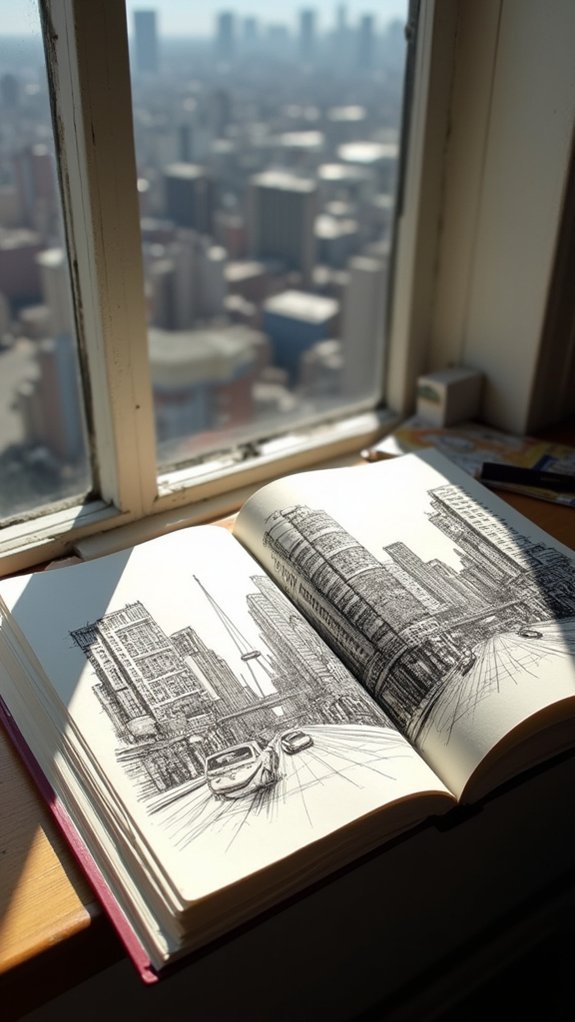
A lot can happen right outside a window, making it the perfect spot for urban sketching adventures without ever leaving home.
Even if it’s just one subject—like that old lamppost or the neighbor’s strange potted plant—a simple view turns wildly interesting the moment you start to notice the changing light. Shadows stretch then shrink, and suddenly your scene feels new every hour!
Sketching from your window lets you experiment with perspective and capture street life, all while staying cozy.
Rainy days? Sketch umbrellas. Sunny days? Try sketching the same thing, but watch how the sunlight transforms everything.
Adding people, cars, or even that sneaky squirrel racing power lines kicks up the drama.
Mix ink and watercolor for energetic, lively sketches that truly pop!
Exotic Animal Illustrations
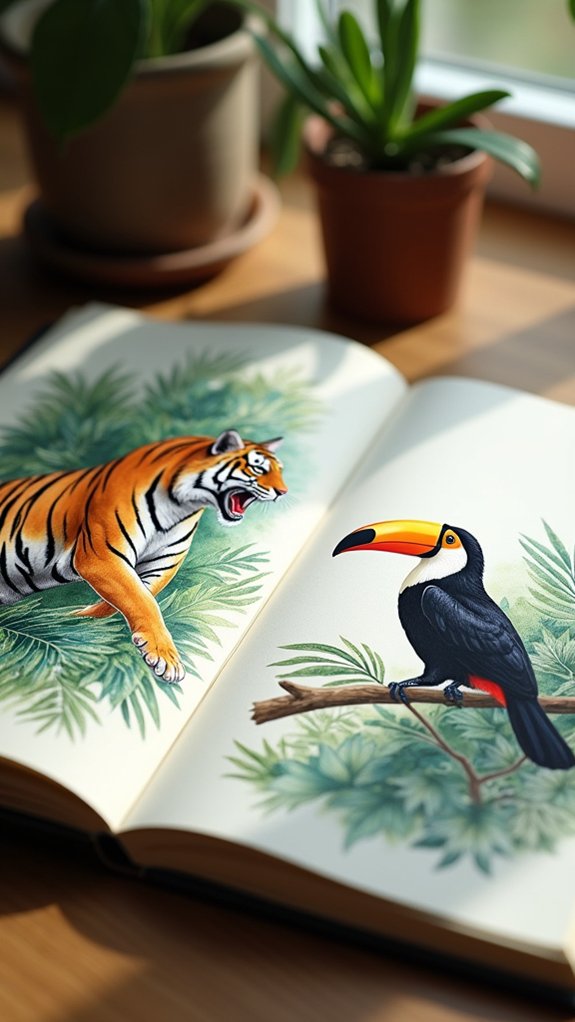
Immerse yourself in the wild world of exotic animal illustrations, and suddenly sketchbooks start to feel like tiny passports for adventure. Choosing five favorite exotic animals gives every page a new kind of energy—think stripes, scales, feathers, and fur! It’s the ultimate mix for people who love drawing. Focusing on tiny details, like a lizard’s bumpy skin or a tiger’s wild coloring, will make every sketch pop. Brush pens let artists really get into those textures. Experimenting with watercolor or ink adds another layer of coolness. Sharing your animal art on social media? Expect feedback and maybe a sketchbook tour video! Here are some ideas to get you started:
| Animal | Medium Suggestions |
|---|---|
| Toucan | Brush Pens, Watercolor |
| Chameleon | Ink, Colored Pencils |
| Tiger | Brush Pens, Ink |
| Pangolin | Watercolor, Brush Pens |
| Red Panda | Colored Pencils, Ink |
Portraits From Photo References
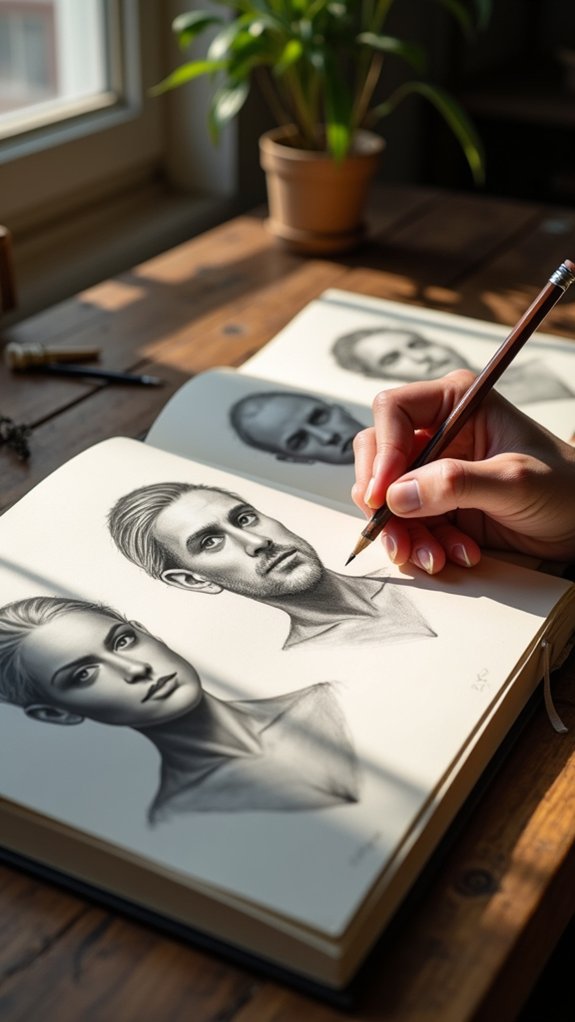
After sketching wild creatures from across the globe, it’s time for some close-up magic—faces!
Portraits from photo references offer a fantastic way to practice those tricky facial proportions while also letting artists dive deep into expressive portraits. Not every photo will do the trick—pick high-quality photo references with clear lighting and sharp features, so every eyebrow or dimple stands out.
Want a challenge? Try drawing faces from odd angles or with interesting expressions; it’s awesome for building skills. Play around with pencils, ink, or watercolors—each medium brings out a new side of your style.
And, don’t shy away from drawing folks from all kinds of backgrounds. It’ll sharpen your observation and help those sketches leap off the page with real personality!
Seven-Day Daily Drawing Challenge
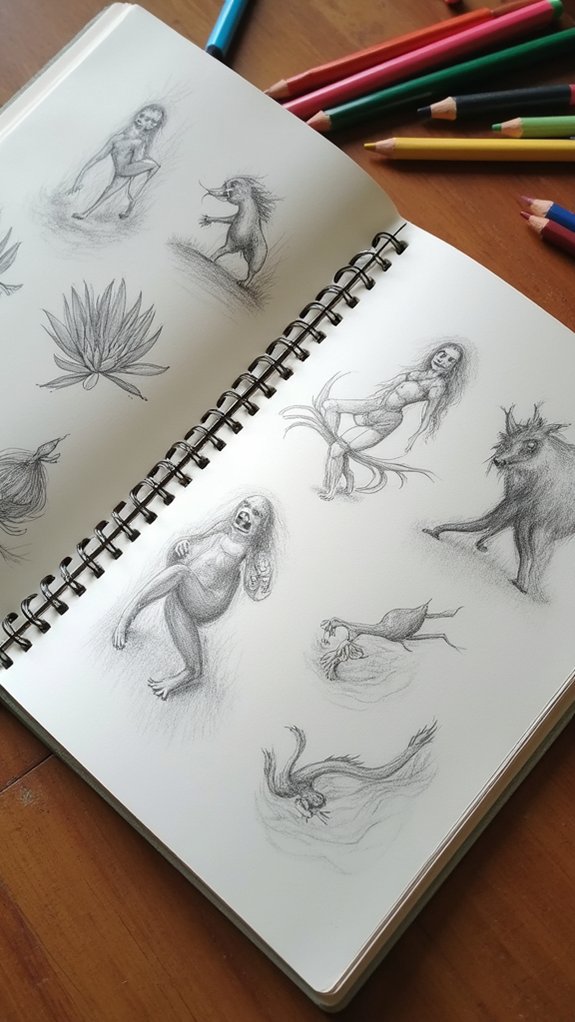
How does someone go from blank page to art streak in just a week? The Seven-Day Daily Drawing Challenge makes it possible!
Imagine picking up your sketchbook every single day, searching for something simple in your surroundings—a mug, a shoe, even your pet’s weird sleeping pose. The goal isn’t perfection; it’s building mini-habits, drawing with a grin (and maybe a smudge or two).
Inspiration is everywhere, so grab an inspiring reference and let your hand do the talking, even if your pencil sometimes whispers, “Oops.” If you’re feeling bold, share your progress online for applause, encouragement, or friendly doodle debates.
- Pick a different theme for each day
- Use simple objects as subjects
- Embrace messy, imperfect sketches
- Stay consistent and draw every day
- Share your art for feedback and inspiration
Drawing With a Limited Colour Palette

Trying to pick just a few colors for your artwork can feel like being dropped into a candy store and told you can only choose three treats—tricky, but weirdly exciting!
By sticking to a limited palette and really pushing those colors for lights, darks, and everything in between, artists can make their sketches pop with contrast and personality.
Focusing on how just a few shades work together not only makes each drawing feel united but also turns the challenge into a fun, creative game.
Choosing Your Palette
Envision this: a box of crayons with just a handful of colors, yet endless possibilities still burst to life on the page. That’s the magic of choosing a limited palette—it sparks creativity by making you think differently about colour, shapes, and expression.
To kick things off, pick three bold hues (primary or secondary) and add black. This creates a palette that’s both simple and powerful. Test drive your selection by building a colour mixing chart to see what wild shades you can create.
Every week, shake things up with new combinations to keep your sketches feeling fresh and balanced. With fewer colours, there’s less overthinking, more fun, and tons of new techniques to try.
- Select three primary or secondary colours plus black
- Build a mixing chart to explore possible shades
- Change combinations each week for variety
- Focus on creativity and composition, not options overload
- Notice how a limited palette can unify your sketches
Enhancing Depth With Contrast
Plunge into the world of contrast, and suddenly, even a simple color scheme feels like it’s packed with drama. With a limited colour palette—maybe just three trusty colors—you get to see how much depth and contrast you can squeeze out of just a few hues.
Want to make your drawing pop? Try messing around with tonal variations, mixing light, middle, and dark shades of your chosen colors. Make a quick color mixing chart; it sounds fancy, but it’s basically doodling swatches to see how your colors play together!
Turns out, using fewer colors actually pushes your creativity, leading to art that feels both bold and harmonious. Experimenting this way keeps things simple, but the results? Way more impressive than you’d think.
Famous Landmark Studies
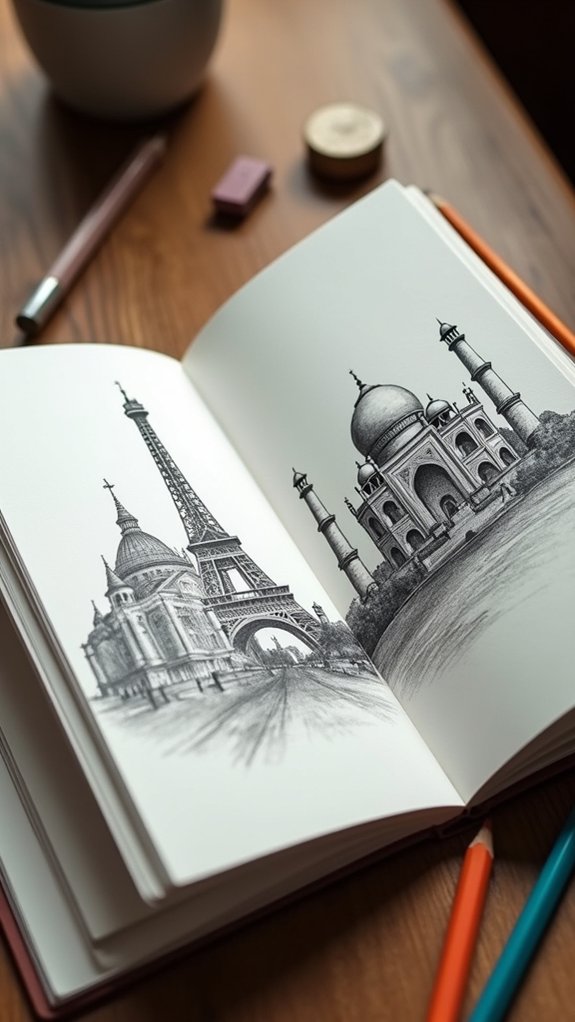
Many sketchbook artists love the challenge of capturing the world’s most famous landmarks, from the spindly Eiffel Tower to the mighty Colosseum or the sparkling domes of the Taj Mahal.
Tackling these grand icons in sketches is so much more than just drawing buildings; it’s a way to study awe-inspiring architecture through fresh perspectives and push creative boundaries.
Artists can make their sketchbooks feel like a world tour, testing out new angles, adding a dash of local scenery, or jotting down quirky facts that make each landmark pop with personality.
Trying different mediums—maybe splashes of watercolor or bold ink lines—keeps things exciting.
- Explore multiple perspectives for each landmark
- Add context with environmental details
- Mix mediums for texture and color
- Research history for extra flair
- Create a themed landmarks series
People Sketching in Public Spaces

While some artists might feel a bit nervous pulling out their pencils in a crowded park or busy café, sketching real people as they go about their day can be one of the most exciting—and unpredictable—adventures in a sketchbook.
People sketching in public gives artists the chance to capture all kinds of expressions, cool hairstyles, and quick movements. It’s like an amusement park for your observational drawing skills.
Since people don’t stay still, artists have to move fast, which makes it more fun—and yes, a little challenging. If you need a boost, try the 100 heads challenge or check out what other artists post on social media.
Paint Without a Pencil Sketch

Forget the pencil lines—just grab a brush and start painting! When artists decide to paint without a pencil sketch, it opens up a world of energy and boldness. There’s no safety net, which can be exciting (and maybe a little terrifying).
Instead of tiny details right away, let a wash of color become your starting point. Watch as colors swirl and blend, and don’t worry about staying perfectly inside the lines—there aren’t any! Use different brush sizes and play with leaving white space for cool effects.
Sometimes the messiest parts create magic. When it feels almost finished, step back and add some final touches to make things pop.
- Experiment with color placement
- Leave intentional white space
- Welcome happy accidents
- Layer for depth
- Finish with bold final touches
Natural Texture Studies

After letting bold color and messy brushstrokes take center stage, it’s time for something a bit more grounded—getting up close and personal with the wild world of natural textures. Imagine running your pencil over tree bark, or capturing the delicate veins in a leaf on the page of your sketchbook. Nature’s textures are everywhere, and zooming in on these tiny details can seriously level up your drawing game. Mix things up by trying out watercolor or ink as you explore rough rocks, shiny wet stones, or fuzzy moss. Don’t forget to play with light and shade, watching how they transform the simplest surface. Keep your texture studies in one sketchbook, so you can flip back and see how much you’ve improved!
| Texture Source | Recommended Medium |
|---|---|
| Tree Bark | Ink |
| Leaf | Watercolor |
| Rock | Pencil Shading |
| Moss | Colored Pencil |
| Pebble | Watercolor & Ink |
Sketch the Same Subject in Multiple Styles
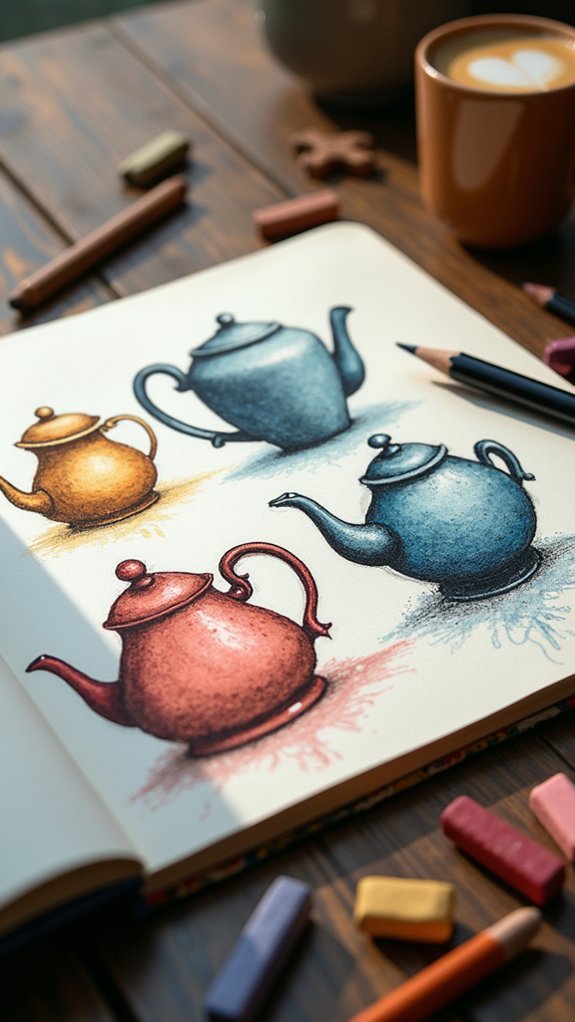
Trying out different styles on the same subject can turn a basic drawing into something totally surprising—it’s like seeing one thing in a bunch of wild new ways, just by switching up your approach.
Swapping pencils for markers or pushing the contrast between light and dark gives each sketch its own mood, and sometimes the results are so weird or cool you’ll wonder, “Did I really do that?”
Over time, looking back at these experiments can actually show how much your style has shifted, which is both awesome and a little hilarious if you remember where you started.
Exploring Different Artistic Approaches
Although it might sound a bit wild at first, sketching the same subject over and over—each time in a totally different style—can be a real game-changer for any artist.
Taking a single drawing idea and reimagining it in different techniques, like bold ink lines or soft watercolor washes, helps you see your subject in entirely new ways. Each attempt forces you to rethink your choices—should the composition be dramatic or simple, the texture rough or smooth?
This process doesn’t just boost your skill; it’s like discovering secret pathways in your own creativity! Plus, tracking your progress makes the entire experience even more rewarding.
- Experiment with fresh drawing techniques
- Change up composition styles each time
- Compare results to spot unique qualities
- Focus on color, line, and texture differences
- Document progress with thumbnails or videos
Contrast Techniques and Materials
Even the most ordinary sketch can turn into something totally unexpected when artists mess around with different styles and materials.
Picture drawing the same object three times: first in realistic detail, then as a wild abstraction, and finally as a goofy cartoon. It’s like hosting an art talent show, and your subject is the star!
This experiment isn’t just about copying, it’s about technique—maybe playing with thick, moody charcoal lines one minute, splashing bright watercolor the next, or inking super-sharp outlines for drama.
Each material brings a new mood, making even a plain drawing surprisingly cool. By documenting the process, like snapping photos or videos, artists can actually see what techniques click and spot materials that make their creativity blast off in unexpected directions.
Noticing Style Evolution
After playing around with different materials and techniques, artists might start to wonder how their own style shifts from sketch to sketch.
Well, that’s where the real magic begins! Drawing the same subject in multiple styles is like giving yourself permission to go wild with ideas. One cow, five different destinies—cartoon, realistic, abstract, maybe even pixel art!
Trying out all these looks, artists can see which style pops, which feels awkward, and which just fits. Not only does this spark creativity, but it seriously boosts confidence over time.
Want to level up faster? Try filming your sessions—watching them back is enlightening and, honestly, sometimes hilarious.
- Experiment with various techniques and materials.
- Discover personal style preferences.
- Refine observational drawing skills.
- Explore new drawing ideas.
- Document progress and style evolution.
Just One Large Brush Painting

Some days, grabbing just one big brush feels like the boldest move an artist can make. Instead of worrying about tiny details, this challenge flips the usual drawing process on its head.
With a large brush loaded with watercolor, artists focus on bold shapes and broad sweeps. Suddenly, the page feels like a playground! Mistakes? It’s impossible—not with wild, splashy washes of color taking over.
This approach sparks creativity, teaching brush control and how to build up texture and depth with just a few strokes. Starting with a light wash as a base, each new layer adds excitement and drama.
Perfect for vistas or even abstract ideas, this technique is all about letting go and seeing where the paint wants to go next.
Watercolour and Mixed Media Experiments
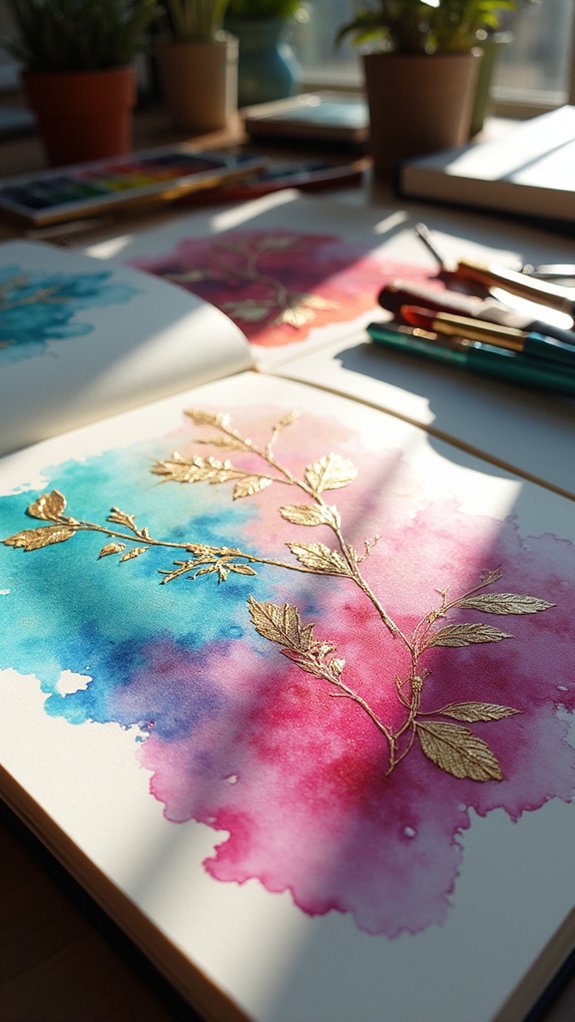
Plenty of artists know the thrill of watching watercolour swirl across the page, but things get really interesting when different art supplies jump in too.
Mixing watercolour with pencils, markers, or even a dash of gouache can transform flat washes into bold, textured adventures. Every brushstroke, scribble, or splatter has potential for surprise!
Artists can amp up the fun and texture by sprinkling salt or pressing plastic wrap onto wet paint—wait and see what patterns appear. Exploring mixed media is about playful discovery, not perfection.
To get started:
- Combine watercolour with coloured pencils or markers for cool mixed media effects.
- Experiment with salt or plastic wrap for unpredictable texture.
- Try blending with three basic colours to make a handy colour mixing chart.
- Let loose with water-soluble inks for dynamic layering.
- Stick to one big brush for brave, juicy strokes and fresh texture.
Create a Thematic Sketch Series
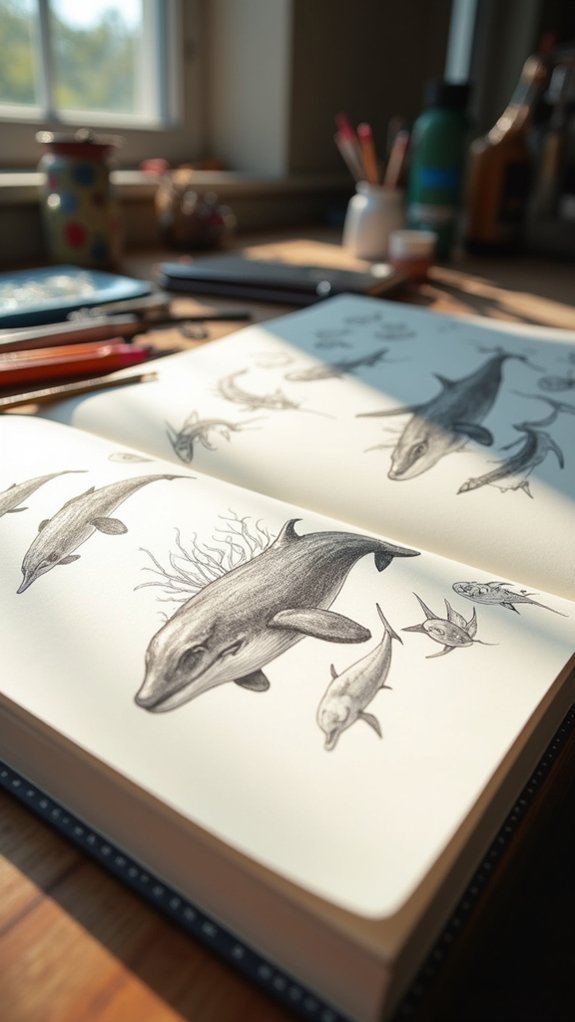
Mixing paints and playing with textures can spark all kinds of wild ideas, but sometimes picking a theme gives your art a whole new buzz.
Choosing a theme—like local landmarks, weird hats, or even just using green—lets artists build a thematic sketch series with style and purpose. Dedicating a bit of time daily to tackle a new drawing keeps the creative process rolling, with each sketch adding a twist.
Number the sketches and use a similar layout so your series doesn’t look like puzzle pieces from different boxes. Don’t sweat the wonky lines—embracing imperfections makes drawing way more fun.
Document your progress, then show off your themed series on social media. You might even get feedback that rockets your motivation to a whole new level!
Light and Shadow Explorations
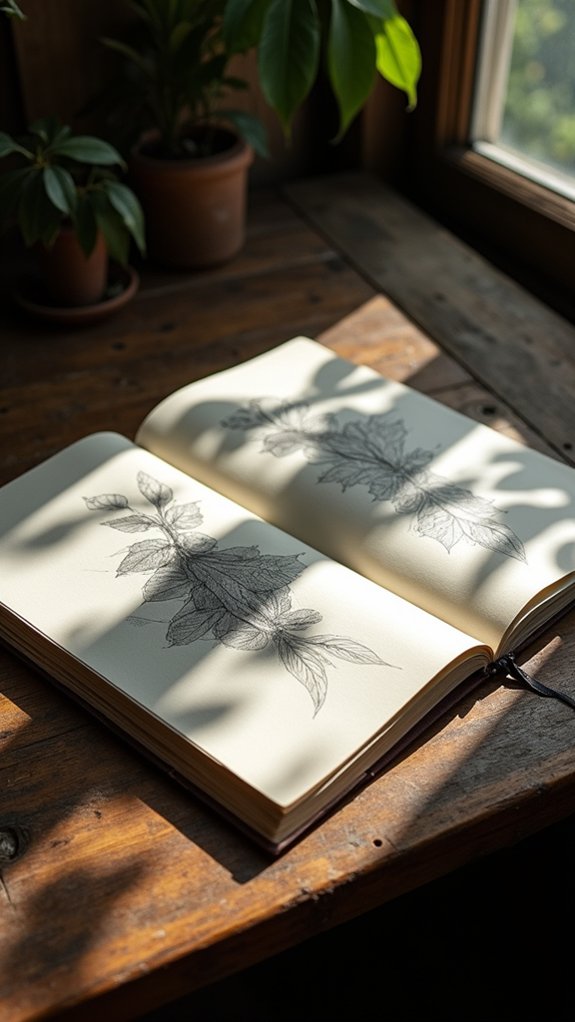
Nothing brings a sketch to life quite like playing with light and shadow. When jumping into drawing, experimenting with how light hits an object can totally transform your artwork.
Try picking one thing—a sneaker, a mug, maybe even your lunch—and notice how it changes as the sun shifts or a lamp beams down. Watching shadows dance and highlights pop is like setting the stage for your subject.
If you’re feeling brave, dip into watercolors, layering calmer and darker tones to show how deep or crisp those shadows go. And hey, don’t forget, even empty space (yep, negative space) can help your drawing feel balanced and bold.
- Observe one object under changing light sources
- Use watercolor shading for depth
- Render textures on natural elements
- Sketch scenery at different times
- Practice defining shapes with negative space
Draw This In Your Style’ Challenge

After trying out light and shadow tricks, it’s time to shake things up with a trend that sets social media buzzing: the ‘Draw This In Your Style’ challenge. This wildly fun activity lets artists reinterpret a cool character or drawing, mixing in their own creativity and showing off their unique artistic voice. It’s all about taking an idea, flipping it your way, and sharing your piece online. Watch as hashtags fill up with hundreds of reimagined versions, each bursting with personality and surprises! It’s not just a popularity contest—artists build community, trade tips, and gain confidence. Plus, who knows? Someone might spot your art and become your biggest fan. Here’s how this challenge works:
| Step | Benefit |
|---|---|
| Pick artwork | Spark creativity |
| Reinterpret style | Grow artistic voice |
| Post online | Gain visibility |
| Join the buzz | Make art friends! |
Comic Strip of Your Week

Whether it’s an epic fail at gym class or an unexpected pizza party, every week is packed with moments just begging to be turned into art.
Turning these memories into a comic strip is a creative way to look back with a smile—or a groan! First, start by making a list of ideas from your week: the memorable, the weird, or just super fun to draw.
Pick two colors plus black to keep your style sharp but interesting. Draw your comic strip’s title at the top, numbering each new week for that collection vibe.
Sketch and ink each moment in order, letting bold copic lines pop off the page. Don’t forget those final touches!
- Create a list of ideas from your week
- Choose a consistent color palette
- Design a catchy title and use creative lettering
- Illustrate each event in sequence
- Add final touches, combining text and linework
Dynamic Sketchbook Spread Layouts
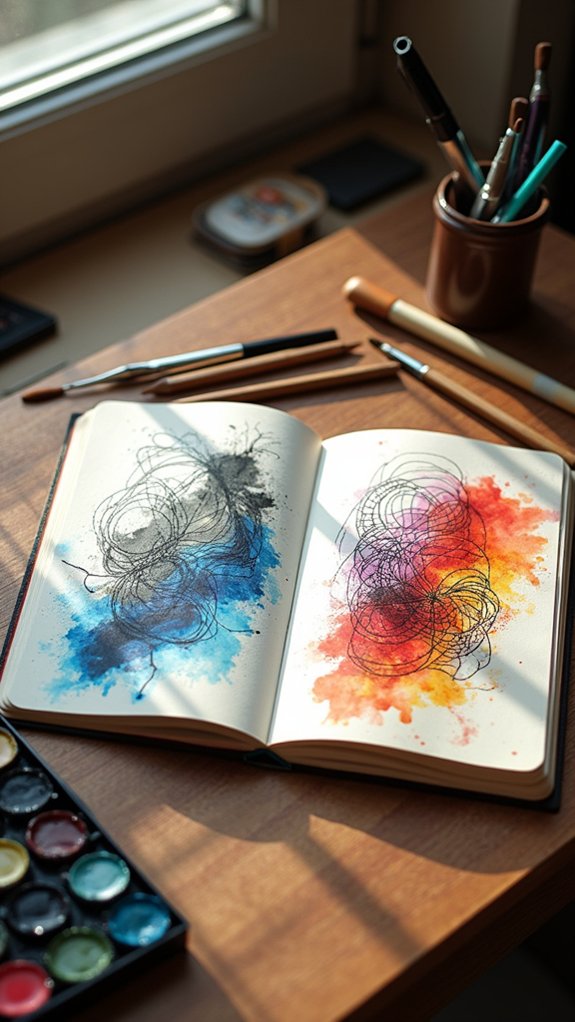
A ton of sketchbook artists know that how you lay out a page can make the difference between a “meh” spread and one that totally wows you.
Dynamic layouts aren’t just about making a messy jumble—they’re about creating a cool path for the eyes to travel across the page. Throw in some negative space, and suddenly everything can breathe, instead of squishing together like sardines at a party.
Mixing it up with varied sizes of sketches—maybe a giant cat head lording over tiny doodle mice—adds instant energy and fun. Don’t be afraid to include foreground and background elements, either.
If you want to plan ahead, try making some tiny thumbnail sketches first. That way, your spread packs a punch, not a headache!
Head and Shoulders Portrait Marathon
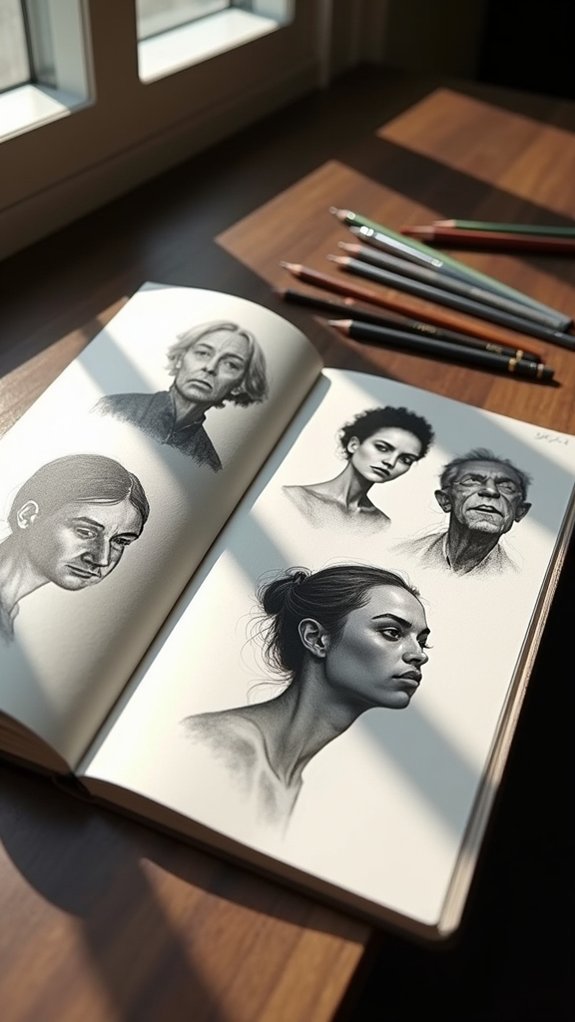
Now, get ready for a head and shoulders portrait marathon that’ll seriously challenge your sketchbook skills!
Quick portrait study sessions are perfect for capturing faces fast, while trying out wild expressions can make your sketches way more interesting (plus, it’s kind of hilarious).
Over time, artists start noticing which techniques work best for them, helping their portraits look more consistent and confident page after page.
Quick Portrait Study Sessions
Grab a sketchbook and prepare for a wild ride—quick portrait study sessions are here to shake up your drawing routine. Imagine setting a timer, flipping to a fresh page, and diving into a speedy observational drawing of someone’s head and shoulders.
These sessions aren’t about perfection; they’re about catching the spark in a glance, or the curve of a jaw before you even have time to overthink! Use wild lighting or quirky angles—your quick portrait study might just surprise you. Finish your sketches with confident final touches, or keep them loose and lively.
Sharing your progress online turns this marathon into a group adventure where everyone cheers each other along.
- Sketch one head-and-shoulders portrait each day
- Choose references with varied lighting
- Capture essential features quickly
- Embrace mistakes—spontaneity rules
- Share and learn from feedback
Exploring Facial Expressions
Those quick portrait studies were just the warm-up, because it’s time to level up—let’s put those faces into action!
Now comes the Head and Shoulders Portrait Marathon, where sketching bursts with wild, unpredictable expressions. Grab your pencil (or maybe ink for some real drama), and start drawing faces with emotions like joy, sadness, anger, or even surprise that looks like someone just stepped on a LEGO.
Use reference images if you need inspiration, or maybe ask a friend to pull a silly face. Challenge yourself: try sketching a set number each day. By shooting for 100 heads, you’ll see your skills and speed skyrocket.
Don’t forget to share your progress online—it’s way more fun with feedback and a cheering squad!
Developing Consistent Techniques
Kicking off a true portrait marathon, artists find themselves facing the ultimate practice test: drawing head and shoulders over and over until it feels like second nature.
The goal? Developing consistent techniques while still having a little fun along the way! Try drawing portraits from all sorts of angles—maybe Grandpa’s big grin or your best friend’s mysterious smirk.
As you keep going, don’t forget to experiment with charcoal, ink, or whatever medium is calling your name. Adding those final touches might seem tricky at first, but you’ll nail them with practice.
Plus, sharing your sketches online can bring feedback and some well-deserved cheers.
- Participate in the 100 heads challenge for rapid progress
- Sketch from both live models and reference photos
- Set daily portrait drawing goals
- Switch up styles and mediums
- Post progress online for support
Frequently Asked Questions
What Can an 11 Year Old Draw?
An 11-year-old may enjoy drawing cartoon characters, nature scenes, and experimenting with simple shapes. These subjects encourage development of observation, creativity, and foundational skills, allowing artistic growth while making the process approachable and enjoyable for young artists.
Which Drawing Is Trending Now?
The current question concerns popular trends in the art community. Digital art continues to rise, while portrait drawing—especially of diverse faces—and abstract sketches with expressive lines and color remain both relevant and widely practiced among artists today.
What Do I Draw on My Sketchbook?
When considering what to draw in a sketchbook, artists can explore character design techniques, apply nature sketching tips for botanical or scenery studies, or try urban doodling ideas, capturing architecture and street scenes for creative development and skill enhancement.
Which Drawing Should I Draw Today?
When considering which drawing to create today, one can consult daily drawing prompts or explore art inspiration sources. Incorporating new sketching techniques tips, such as perspective or shading, may also influence the subject chosen for today’s artistic practice.
Conclusion
No more staring at blank pages—these 20 sketchbook ideas can kickstart anyone’s creativity. Some are wild, and some are way chill, but all of them will help any artist try something new. Mix it up, draw messily, make mistakes, and laugh at them—every page is just practice, not a masterpiece. In the end, it’s all about enjoying the process. So, pick your favorite idea, grab your pencil, and let the sketching adventures begin!

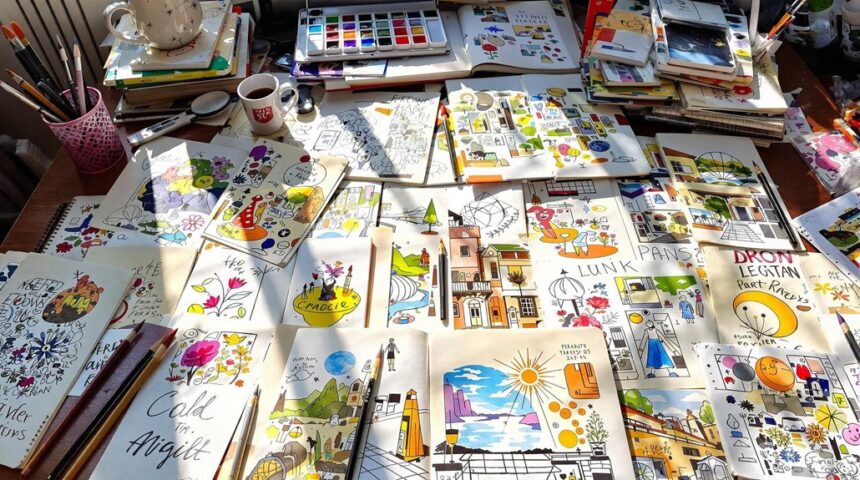
Leave a Reply